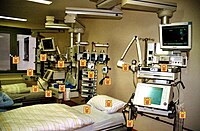
Photo from wikipedia
This study suggests that risk of exposure to COVID-19 in healthcare personnel approximates community risk levels, provides support for safety measures in the workplace and emphasizes the need for prevention… Click to show full abstract
This study suggests that risk of exposure to COVID-19 in healthcare personnel approximates community risk levels, provides support for safety measures in the workplace and emphasizes the need for prevention in the community. Objective The aim of this study was to describe the rate of household, community, occupational, and travel-related COVID-19 infections among health care personnel (HCP). Methods In a retrospective cohort study of 3694 HCP with COVID-19 infections from July 5 to December 19, 2020, we analyzed infection source data and rates, compared with local and state infection rates, and performed a correlation analysis. Results Household (27.1%) and community (15.6%) exposures were the most common sources of infection. Occupational exposures accounted for 3.55% of HCP infections. Unattributable infections (no known exposure source) accounted for 53.1% and correlated with community rather than occupational exposure (R = 0.99 vs 0.78, P < 0.01). Conclusions COVID-19 infections in this large HCP cohort correlated closely with infection rates in the community. The low incidence of occupational infections supports the effectiveness of institutional infection prevention and control measures.
Journal Title: Journal of Occupational and Environmental Medicine
Year Published: 2022
Link to full text (if available)
Share on Social Media: Sign Up to like & get
recommendations!